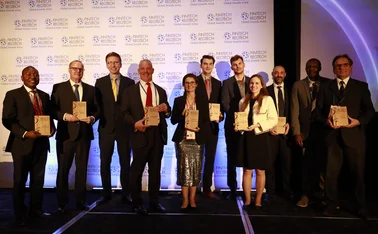
Asset manager of the year: State Street Global Advisors
US asset manager takes customisation to a new level

The past year has proven particularly challenging for central bank reserve managers. Not only did the low-yield environment persist against a backdrop of monetary policy uncertainty in the US and Europe, but political events also had an impact on markets – particularly the UK's decision to quit the European Union and Donald Trump's election as the new president of the US.
While political developments have always made interesting talking points, such events have had a limited impact on market volatility over the past couple of decades. This changed dramatically in 2016. For example, few reserve managers expected a surge in bond yields from a Trump victory. As a result, there may be a need to factor uncertainty into decision-making in future, in addition to the widespread use of quantitative analysis in managing financial risks.
Added to this heady mix is the continued weakness in commodity prices and expectations of an imminent end to the bond-market cycle. Global foreign exchange reserves have also fallen sharply, albeit most of the decline was concentrated in China, Russia and Saudi Arabia. Despite this, central bank reserve managers sought ways to improve returns in fixed income and equities, while sovereign wealth funds shifted further along the risk spectrum into alternative investments, including real estate, multi-asset products and private equity.
State Street Global Advisors (SSGA) is one of only a handful of counterparties able to help official institutions to address these challenges around the world. It manages $359 billion of assets for 84 official institutions and the recent addition of GE Asset Management gives it new strength in active fixed-income (FI), fundamental equity, real estate and private equity investments.
Active FI and equities
Bottom-up research by State Street estimates that of the 15% of total reserve assets held by central banks in their investment tranches, 90% of the new money allocations made by 2020 will be in passive equity or active fixed income – the latter bucking the broader investment trend, but perhaps not surprising given the prospect of a secular rise in interest rates.
State Street has excelled in providing solid service offerings in both of these areas. "The quality of services remained on a very high level," says Jan Schmidt, executive director at the Czech National Bank, which holds more than $8 billion in passive equities – some $4 billion with SSGA.
Moreover, the addition of GE Asset Management has "opened interesting dialogue opportunities", according to Louis de Montpellier, global head of the SSGA's official institutions group (OIG). This includes active fixed-income opportunities for reserve managers and, in particular, access to north American real estate for sovereign fund clients.
De Montpellier declined to provide concrete examples of new deals with sovereign institutions that have emerged as a result of the GE Asset Management purchase. But, given roughly 15% of the Boston-based firm's clients are sovereign institutions, State Street can afford to take a long-term relationship approach.
In the meantime, it has offered bespoke services to the clients of several official institutions, ranging from re-optimising the portfolio of a commodity-exporting nation to developing a customised exchange-traded fund (ETF) for a sovereign fund.
State Street also encourages customers that are trying to reform their investment approaches. "Do not accept the world as it is. Imagine what it ought to look like, and if that means regulators or your board need to adjust, convince them to do so," says Elliot Hentov, head of OIG policy and research.
Redefining bespoke
In common with its peers, the Boston-based company offers asset-management training in exchange for winning important mandates. Such knowledge transfers raise the question of sustainability once clients have mastered credit, equities, real estate and even private equity investing. But SSGA's work with one of the world's oldest sovereign wealth funds, Alaska Permanent Fund Corporation (APFC), hints at what may become more common in the future.
APFC, which manages the assets of the $54 billion Alaska Permanent Fund, has developed considerable asset-management acumen internally, but it still lacks the scale, brand power and distribution platform of a top-flight global asset-management company. So APFC used SSGA to launch a series of exchange-traded funds (ETFs) through the latter's SPDR platform.
APFC served as a cornerstone investor for three US-listed smart beta ETFs launched by SSGA on December 2, 2015, which are traded on the NYSE Arca exchange. APFC reportedly invested $1 billion of its own money. The ETFs, which are designed to track the performance of rules-based indexes from FTSE Russell, were created for investors that want to tailor their specific risk-and-return objectives related to yield, volatility and momentum while maintaining a core position within US equities.
The SPDR Russell 1000 Yield Focus ETF has attracted $385.47 million in assets, the Low Volatility Focus ETF $410.97 million and the Momentum Focus ETF $431.54 million. All of these funds are said to be larger than their initial launch size, although it is unclear whether other official institutions have invested in them.
Client customisation also entered a new dimension with the Government National Mortgage Association (Ginnie Mae), the US government-owned corporation within the Department of Housing and Urban Development (HUD), which has increased its share of total US agency gross mortgage-backed securities (MBS) issuance to 36% since the global financial crisis, outstripping Freddie Mac and approaching that of Fannie Mae. Its total issuance was $490 billion in fiscal year 2016.
After being selected through a formal, competitive process, SSGA secured a one-year contract with four option years to help Ginnie Mae achieve the objectives of the global investor advisory services programme. Among its responsibilities, SSGA is helping Ginnie Mae to quantify the investor value premise for its MBS, deliver a compelling message to both existing and potentially new institutional investors, and arrange domestic and international road shows, most recently in north Asia's large economies of Japan, China, South Korea and Taiwan. The aim was to explain the risk-and-return profile of Ginnie Mae MBS, notably addressing issues related to pass-through, amortisation and pre-payment.
Only users who have a paid subscription or are part of a corporate subscription are able to print or copy content.
To access these options, along with all other subscription benefits, please contact info@centralbanking.com or view our subscription options here: http://subscriptions.centralbanking.com/subscribe
You are currently unable to print this content. Please contact info@centralbanking.com to find out more.
You are currently unable to copy this content. Please contact info@centralbanking.com to find out more.
Copyright Infopro Digital Limited. All rights reserved.
As outlined in our terms and conditions, https://www.infopro-digital.com/terms-and-conditions/subscriptions/ (point 2.4), printing is limited to a single copy.
If you would like to purchase additional rights please email info@centralbanking.com
Copyright Infopro Digital Limited. All rights reserved.
You may share this content using our article tools. As outlined in our terms and conditions, https://www.infopro-digital.com/terms-and-conditions/subscriptions/ (clause 2.4), an Authorised User may only make one copy of the materials for their own personal use. You must also comply with the restrictions in clause 2.5.
If you would like to purchase additional rights please email info@centralbanking.com







